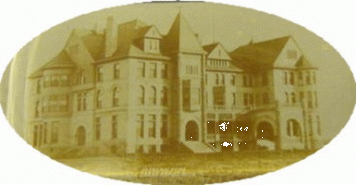
"History of Grand Rapids"
Goss, 1906
Pages 1292 - 1296
On November 5, 1885, several well-known citizens and Masons of Grand Rapids and
vicinity formed articles of association for building a Michigan Masonic Home for
aged or destitute Masons and for Masons’ widows and orphans, and to provide for
their moral, physical and intellectual culture. The following were the charter
members: Jno. D. Jennings, Grand Rapids; Edward D. Benedict, Grand Rapids; Wm.
Dunham, Grand Rapids; Jacob Barth, Grand Rapids; E. J. Horton, Grand Rapids;
Samuel E. Watson, Grand Rapids; W. C. Denison, Grand Rapids; Geo. W. Thompson,
Grand Rapids; Charles F. Cobb, Grand Rapids; J. L. Anderson, Grand Rapids; A. J.
Elliott, Grand Rapids; Homer W. Nash, Grand Rapids; T. J. Lucas, Grand Rapids;
R. D. Swartout, Grand Rapids; Fred K. Baker, Grand Rapids; John T. Holmes, Grand
Rapids; U. S. Hayes, Grand Rapids; A. B. Kennan, Grand Rapids; A. H. Fowle,
Grand Rapids; J. Goldsmith, Jr., Grand Rapids; R. F. Morse, Whitehall; V. V.
Campbell, Grand Rapids; H. C. Taft, Grand Rapids; A. B. Botsford, Grand Rapids;
Thos. D. Bradfield, Grand Rapids; Geo. B. Catlin, Grand Rapids; Wm. P. Innes,
Grand Rapids; Crawford Angell, Grand Rapids; C. D. Stebbins, Sparta;
Chas. S. Robinson, Grand Rapids; Andrew T. McReynolds, Grand Rapids; Victor H.
Middleton, Grand Rapids.
The association accumulated funds and purchased a farm near Reed’s Lake,
which constitutes the present site of the Home. A portion of the farm was soon
sold so advantageously that the grounds of the Home cost the association
nothing. Plans for building were proposed and work commenced. On March 21, 1889,
the corner stone was laid with appropriate ceremonies, at which time Grand
Rapids saw the largest gathering of Masons and Masonic ladies ever seen in
Michigan. Lodges and commanderies were present from all over western and
southern Michigan, and leading Masons came from distant parts of Michigan and
from other states. In the morning a parade of Masonic bodies took place, with H.
T. Hastings as chief marshall. The line of march was from Bridge street, through
Canal, Monroe, Division and Oakes streets, to the Union Depot, where four
special trains were required to take members of the order to the lake. Hugh
McCurdy, of Corunna, delivered the address. After the corner stone was placed
contributions for the Home were called for, and amid much enthusiasm thousands
of dollars were pledged by individuals and Masonic bodies in a short time.
The work of building rapidly progressed, and the next year a grand Masonic
fair was held for the benefit of the Home, at which time more than $20,000 in
cash was realized and about $5,000 worth of furniture for the Home was donated.
Grand Rapids never saw a more successful fair for charitable purposes. The
spirit of giving was in the air and seemed contagious. The formal opening was on
Monday night, November 10, 1890, when Mayor Edwin F. Uhl delivered an address of
welcome, to which response was made by John S. Cross, grand master of the Masons
of Michigan. The fair was held in Hartman Hall, now the Auditorium. There were
booths on every hand. The hall was adorned in the grandest style. Music, flowers
and decorations abounded in wild profusion. It was made a grand society event,
and visitors came in thousands from neighboring cities and towns. Afternoons and
evenings, the hall was thronged with crowds, gay and giving. Saturday night, at
midnight, the Masonic fair came to an end. The officers of the fair were the
following: Brother Heman N. Moore, director-general; Brother H. F. Hastings,
first vice-director-general; Brother Wm. Dunham, second
vice-director-general; Brother Wm. P. Innes, secretary-general; Brother Jacob
Barth, treasurer-general.
General Executive Committee (includes chairmen of all subcommittees): Brother
Heman N. Moore, ex-officio chairman; Brother H. F. Hastings, chairman of
Committee on Booths and Sales; Brother Wm. Dunham, second vice-director-general;
Brother Wm. P. Innes, secretary-general; Brother Jacob Barth, treasurer-general;
Brother George R. Perry, chairman of Committee on Subscriptions and Donations;
Brother Dr. T. D. Bradfield, chairman of Committee on Halls and Decorations;
Brother George E. Pantlind, chairman of Committee on Music and Entertainment;
Brother Dr. S. R. Wooster, chairman of Committee on Refreshments; Brother Wm. A.
Gavett, chairman of Committee on Transportation; Brother James N. Davis,
chairman of Committee on Printing
Honorary Committee: John S. Cross, grand master F. & A. M. of Michigan;
Brothers Charles H. Axtell, Luman R. Atwater, John H. Armstrong, W. Irving
Babcock, C. F. R. Bellows, Charles H. Brown, Edward D. Benedict, Charles P.
Bigelow, John W. Champlin, Henry Chamberlain, Arthur M. Clark, A. B. Cudworth,
George W. Chandler, Wm. G. Doty, George H. Durand, Wm. Dunham, John W. Finch,
James H. Farnum, John P. Fiske, Thomas Greene, Geo. H. Greene, Theron F.
Giddings, John Gilbert, John A. Gerow, Wm. G. Hudson, Rufus C. Hathaway, Frank
Henderson, R. Allen Hall, Charles T. Hills, Charles J. Kruger, Hollis F. Knapp,
Wm. F. King, W. Irving Latimer, Wm. S. Lawrence, Wm. T. Mitchell, Abram T.
Metcalf, Hugh McCurdy, John W. McGrath, M. H. Maynard, John L. Mitchell, Salmon
S. Matthews, Garra B. Noble, Alanson Partridge, Benjamin Porter, Eugene P.
Robertson, Leonard H. Randall, Daniel Striker, Oliver L. Spaulding, Michael
Shoemaker, Ebenezer Sprague, Alfred I. Sawyer, David C. Spaulding, Wm. S. Turck,
Wm. B. Wilson, Wm. L. Webber, Benjamin F. Watts, Wm. Wente, Thomas H. Williams,
and all past commanders-in-chief of consistories, A. & A. S. R., in
Michigan.
The Home was dedicated on January 27, 1891, with appropriate exercises by the
Grand Lodge of the State of Michigan, and immediately was opened for its
beneficence.
Foundation — The foundation is of a dark stone, from the Holland quarries, in
rock face.
The walls are of white brick, upon a heavy gray stone water table, the wood work
painted terra cotta colors, giving a pleasant contrast.
Basement — The basement has a hall one hundred and twenty feet long and ten feet
wide, and contains a kitchen, pantry, bakery, laundry, dry room, ironing room, a
large play or school room, water closet containing three bath tubs, one room for
gas machine, and water tank for elevator, and four rooms to use as store rooms
for kitchen and bakery. Two flights of stairs leading to first floor.
First Floor — First floor has a hall running north and south the length of the
building, ten feet wide, and two side halls to the west, the main one being
eleven feet wide, leading to the west main entrance of building. Each end of
these halls have vestibules with the floors and iron steps and risers, their
ceilings finished in panel work of native oak. It also contains one closed
vestibule, a reception room, parlor, dining room, a suite of three rooms for use
of matron, with good clothes closets, also seven bed rooms, four of them have
fire-places, and all have clothes closets; a water closet. There is a grand
staircase fronting west entrance, also a stairway at rear entrance of main hall.
Second Floor — The second floor contains hall, day room, a large sitting room
looking out over the lake, a store room for bedding, water closet with bath tub,
a room for library, and twenty bed rooms, each one having a good clothes closet.
This floor has eight fire-places.
Third Floor — Third floor contains halls, hospital, with two water closets and
bath rooms, a large sitting room looking out upon the lake, a store room for
bedding, a water closet for north end of hall, and eighteen bed rooms, each
having a large clothes closet. Eight fire-places are on this floor.
There is a dumb waiter from kitchen to dining room. A hand elevator from cellar
to attic to accommodate each floor, besides a passenger elevator from basement
to attic, and a dust chute from third floor to basement.
Every sleeping room is provided with proper ventilation, each
receiving a current of fresh warmed air through transom over doors, passing out
at base of rooms through tin tubes located in partitions leading to attic, and
out of roof.
Hospital and sick rooms connected therewith have hard wood floors: the dining
room, kitchen, bakery and all halls in building above basement have white maple
floors, finished in oil.
The roof is covered with dark slate, and the building is entered from the
east, west, north and south by stone buttress steps, and having on east and west
sides deep, commodious verandas.
The building is heated by steam from boiler house located ninety feet distant,
conducted through pipes under ground.
It is furnished with soft water from a three hundred and fifty barrel cistern.
For culinary purposes, from a well four hundred feet deep.
The Home accommodates on an average about sixty beneficiaries a year. The cost
of maintenance is about nine thousand dollars per annum, derived from a per
capita tax upon the Masons of Michigan, from various Masonic bodies, and from
individual contributions. There is also a small revenue from the farm. The Home
is for Masons, their wives, widows and orphans, and is a perpetual monument to
the spirit of Masonry. It is an institution in which every Grand Rapids citizen
can have honest pride.
The management of the Home is under the control of the grand Masonic bodies of
the state of Michigan. The present officers and Board of Control are as follows:
President, Maro M. Read, Ypsilanti; treasurer, Wm. Wente, Manistee; secretary,
Rial V. McArthur, Grand Rapids.
Board of Control—Grand Lodge: William Wente, John W. McGrath and Wilson R.
Andress. Grand Chapter: Maro M. Read, Judson E. Ries and E. C. Clark. Grand
Council: Charles L. Fitch, Eli C. Phillips and A. L. Bates. Grand Commandery:
Charles H. Pomeroy, John Rowson and William C. Grobhiser. Eastern Star: Anna A.
Mattison, Helen E. C. Balmer and Margaret G. Moore.
|



